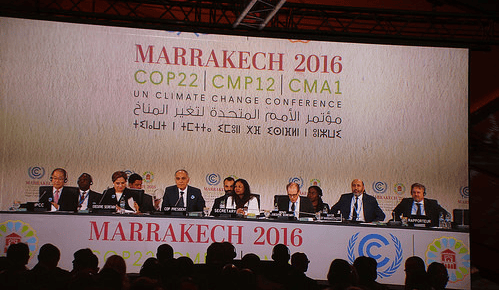
The 22nd session of the Conference of the Parties (#COP22) is taking place from 7-18 November 2016 in Marrakech, Morocco. The event starts just a few days after the entry into force of the Paris Agreement, on November 4, 2016. Analyses, background and future implications from the newsletter of Climate Policy Observer
Almost a year after the success of the Paris climate negotiations, which ended with the adoption of the Paris Agreement on December 12, 2015, the world has already changed a bit. In the past year, we have observed small steps and big contributions to mitigation and adaptation involving different actors and sectors. But exactly where are we? What has changed in the months between the adoption of the Paris Agreement and its enforcement?
Since then, 191 Parties have signed the Paris Agreement, including 175 parties at the UN Headquarters in New York on April 22nd, the opening day of Treaty signing and Earth Day: never has such a large number of countries signed an international treaty on the same day, in one place, under one roof.
But signing, we know, isn’t enough. The Agreement was designed to go into effect one month after its ratification by at least 55 countries responsible for at least 55% of global emissions of greenhouse gases.
Many expected to see it go into effect in 2020, but instead it took place long before, to be precise on November 4, 2016, a few days before the start of COP22, the twenty-second Conference of the UNFCCC Parties (Marrakech, Morocco, November 7-18, 2016), a success made possible by the recent achievement of the two conditions for its enforcement:
- the first “threshold” was crossed (with the ratification of 60 parties) on September 21st, during a special event convened by UN Secretary General Ban Ki-moon at the UN headquarters in New York, where leaders from around the world were invited to deposit their instruments of ratification, acceptance, approval or accession to the Paris agreement;
- the second “threshold” was crossed on October 5th, the day a 58.82% emissions coverage was reached thanks to ratifications by the EU and several of its member States (Austria, France, Germany, Malta, Hungary, Portugal and Slovakia), as well as Bolivia, Canada and Nepal.
Nevertheless, there is still a long way to go. As illustrated by the “Paris Agreement Tracker” map of the World Resource Institute, updated in real time, there are today a total of 83 signatory Parties, responsible for 60.79% of global emissions. Many are still missing. Most importantly, actions to implement the Agreement are still delayed in many countries.
“The biggest challenge now”, writes Carlo Carraro on his blog, “is to make the Paris agreement a reality, starting with the NDCs, from diplomacy to concrete action. With such a rapid enforcement compared to what was expected, several operational details still need to be defined. In addition to their definition, financing and capacity building will be at center stage, in keeping with the direction taken by the Agreement and implicit in its very architecture: to act concretely to mitigate climate change and adapt to it, including all the players – “yesterday’s” leaders with “tomorrow’s” leaders” – of the international scene”.
Read the integral version of the post on Carlo Carraro’s blog.
More information about COP22, coverage, analyses, background and future implications are now available from Climate Policy Observer newsletter and website.
Subscribe Climate Policy Observer newsletter and keep updated on the main news related to #COP22.


